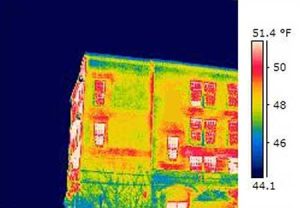In forensic investigations of construction defects, technology has emerged as a  formidable ally, empowering construction defect consultants to provide more accurate insights than ever before. Cutting-edge tools and techniques have revolutionized the ways to approach and resolve complex construction challenges. Following are some of the technological advances currently in use.
formidable ally, empowering construction defect consultants to provide more accurate insights than ever before. Cutting-edge tools and techniques have revolutionized the ways to approach and resolve complex construction challenges. Following are some of the technological advances currently in use.
Advance Imaging and Remote Sensing
With the advance of imaging technologies, such as 3D laser scanning and drone-based aerial surveys, new frontiers in construction defect investigations have opened up. The tools enable consultants to create detailed virtual models for analysis by capturing precise, high-resolution data of buildings and sites. This eliminates the need for more intrusive inspections, minimizes site disruptions, and enhances measurement accuracy. Moreover, remote sensing technologies aid in identifying defects in hard-to-reach areas.
Non-Destructive Testing
Non-destructive testing enables consultants to assess the structural integrity of buildings without causing damage. Techniques like ground-penetrating radar, infrared thermography and ultrasonic testing can reveal hidden defects such as moisture intrusion, voids in concrete, or delamination without compromising a building’s integrity. It also empowers consultants to identify issues early on, enabling timely interventions to prevent further deterioration and minimize risks.
Building Information Modeling
Incorporating building information modeling (BIM) into forensic investigations offers a comprehensive and holistic view of a construction project by creating digital representations of a building, incorporating information about design, construction materials and systems. This assists consultants to visualize the structure’s evolution over time and facilitates identification of any deviation from the original plans. As a result, BIM streamlines the investigative process, enhances collaboration and fosters data-driven decision making.
Data Analytics and Machine Learning
With data analytics and machine learning, consultants can efficiently extract valuable insights. By analyzing vast datasets, these technologies can identify patterns and trends that might otherwise remain unnoticed. This data can be used by the forensic consultant to predict potential construction defects, assess risk levels and recommend proactive maintenance strategies.
Forensic Simulation and Reconstruction
Forensic simulation and reconstruction software enable forensic consultants to simulate various scenarios to understand the complex interactions between elements in a construction project and how construction defects may have occurred. By recreating an event, the consultant can analyze the cause and effects of specific defects to come to a more accurate root cause analysis.
Cloud-Based Collaboration
Cloud-based collaboration platforms facilitate real-time communication, file sharing and data exchange among team members, no matter their geographical location.
Related: An Introduction to Forensic Structural Engineering
Types of Forensic Investigation Tools
Several technologies and methods have emerged as valuable tools for forensic investigation consultants.
3D Laser Scanning
3D laser scanning is a non-intrusive method that captures precise, high-resolution data of buildings and construction sites. It creates a detailed virtual model to aid in identifying defects, irregularities and spatial relationships, eliminating the need for manual measurements and minimizing site disruption during investigations.
Drone-Based Aerial Surveys
Drones equipped with high-resolution cameras offer an aerial perspective and surveys of large of inaccessible areas. They can be used to assess the condition of rooftops, facades and other elevated structures.
Ground-Penetrating Radar
Ground-penetrating radar is a non-destructive testing method using radar pulses to penetrate building materials and reveal hidden defects or voids within concrete, masonry and other materials. It is useful in identifying moisture intrusion and structural anomalies without damage a building’s surfaces.

Infrared Thermography
Infrared thermography detects variations in surface temperatures, revealing potential defects such as water leaks, insulation problems and electrical issues that may not be visible to the naked eye.
Ultrasonic Testing
Ultrasonic testing uses sound waves to assess material integrity and identify defects or internal damage. It can aid in determining the structural soundness of concrete, steel and other critical building components.
See our related post: What is a Construction Forensic Investigation
Why is Technology Important in Modern Forensic Investigations?
When a construction defect or error is indicated, a forensic investigation becomes important for several reasons:
- Identifying the root cause of the construction defect and its underlying reasons
- Establishing liability and responsibility
- Protecting shareholder interests
- Preventing recurrence in future construction projects
- Validating insurance claims to ensure fair compensation
- Enhancing construction industry standards, building codes, regulations and best practices
- Maintaining public trust through a commitment to accountability, safety and quality
Technology in Modern Forensic Investigations by Först Consulting Group
Embracing technology in modern forensic investigations is a necessity for construction defect consultants like Först Consulting Group. It empowers expert consultants like Matthew Furlong to provide comprehensive, informed, practical and authoritative insights to address construction defects and errors effectively.
With the benefit of of extensive experience in forensic investigations, Först Consulting Group provides clients with a thorough investigation, accurate analysis and reporting, resolution recommendations and expert testimony in situations where legal action is necessary. Understand the emotional and financial impact of construction defects, they prioritize their clients’ needs and interests to provide invaluable support to home and building owners.
Först Consulting Group serves the Northern Virginia and Washington DC metropolitan region. Contact Först Consulting Group today to learn more.


